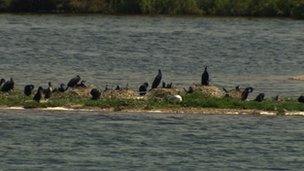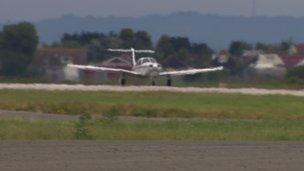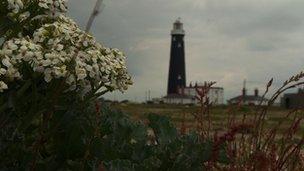Jobs or birds: Turning Rio rhetoric into reality
- Published
- comments

The site is home to many birds
Under the vast skies of a lonely corner of south-east England, a battle over the future of an airport mirrors countless similar contests between Man and Nature around the world.
Amid the stark flat lands of Romney Marsh in Kent, an ancient and eerie terrain of shingle, lakes and reeds, rival forces representing development and conservation are ranged against each other.
Once a haunt for smugglers, the marshes are now better known as the scene of two very different sights: the grey hulks of Dungeness nuclear power station and countless species of birds, many of them exceptionally rare.
The contest is over a plan to transform tiny Lydd Airport into a hub for two million passengers a year.
The question is whether this can take place without doing untold damage to the wildlife.
This is just the kind of challenge on the agenda for world leaders as they prepare to travel to Brazil next week for the Rio+20 summit on sustainable development.
The gathering is a 20th anniversary attempt to rekindle the fires of environmental ambition that marked the famous Earth Summit held in Rio in 1992.
The aim, in theory at least, is to forge a new path in which the actions of this generation do not wreck the chances of the next one.
Many new jobs
The plan in Romney Marsh is to extend the existing runway to make it capable of handling passenger jets to create what will be called London Ashford Airport. In the process, something like 350-400 jobs should be created.
In this eastern edge of Kent, a region blighted by high unemployment, a multi-million pound investment on this scale is music to the ears of some, including the group Supporters of Lydd Airport, external.
Tim Crompton, a spokesman, who runs a local hotel, describes the airport proposal as 'obviously good' for the area - with economic benefits spreading from the airport itself into the wider community through sub-contractors and support services.

Airport expansion threatens wildlife
He points out that the nuclear power station, a major employer, is due to be shut down in coming years and he has no time for those fighting the plan.
"Would you really put birds before jobs?" he asks.
"The reality is that people's progress and people's living and life is more important than a few bits of flora and fauna which will still be here no matter what."
The flora and fauna in question include some unique species of plants, insects and birds that thrive in the unique mix of shingle banks, reed beds and lakes that make up the marshes.
Reed Bunting, Sandwich Terns, Shovelers, Bewick's swans, Bitterns, Grebes and even Purple Heron - all are among those seen in the RSPB's Dungeness reserve, one of its most treasured.
Spokesman Andre Farrar called it: "One of our Crown Jewels - the special of the special."
Legal protection
Such is the value of these wetlands that for decades they have enjoyed the maximum level of legal protection - a Special Area of Conservation, a Special Protection Area and a Site of Special Scientific Interest - meant to provide a 'triple-lock' of conservation.
Andre Farrar says that geology and location have combined to create such a vital area - a shingle peninsula jutting into the Channel.
He said: "It would be a huge mistake to nibble at this special protection for an economic benefit that's probably illusory."
The RSPB is one of several organisations fighting the airport plan, the opposition coordinated by the Lydd Airport Action Group, external.
He points out that one million visitors a year come to the reserve - a potentially vital stream of revenue to the local area.
And this goes to the heart of the struggle in so many parts of the world. The area needs an economic boost but at what cost?
Tim Crompton thinks the birds won't be harmed - the airport was far busier in the 60s and 70s when the planes co-existed perfectly happily with the wildlife.
And if there is a clash, he reckons, the birds' instinct for self-preservation will lead them to move.
Relocation of birds

The site is much loved for its natural beauty
Andre Farrar disagrees. He thinks the threat of bird strikes to the vulnerable engines of passenger jets will make it essential for the birds to be relocated or even killed - safety will require it.
In many cases a possible solution is offered by national legislation.
Projects impacting on the natural world should either be adjusted or provide an equivalent or larger area of terrain in compensation.
The locations and numbers of offshore wind turbines in the London Array wind farm were altered to take account of red-throated divers.
The design of the new London Gateway port includes 'compensation sites' for wildlife forced to move.
Ensuring this system functions successfully is clearly essential if economic growth is not to ruin the natural world - and it has plenty of critics.
A recent study by the Policy Exchange, a pro-free market think tank, identified a failure in the planning process that stifled development while not protecting biodiversity.
The report, Nurturing Nature, external highlighted the importance of the natural environment to economic activity - that ecological processes deliver the resources needed for economic progress - but 11 of 15 of the most important UK habitats are declining.
It found that although particular patches of land are protected, they form 'ghettos' which are not connected by the corridors that wildlife needs.
The report also concluded that protecting areas of land did not always mean protecting particular species and that the effectiveness of compensation schemes for biodiversity was rarely monitored.
The study argued that managing biodiversity needs to be enshrined in the design stages of projects, especially if the principle of a 'net gain' in biodiversity is to be achieved.
No alternative
But what if the area in question is unique, as the conservation bodies say of Romney Marsh?
What if no other areas will offer the same type of terrain and conditions, making 'compensation' impossible?
At the Rio Summit, only the British delegation is likely to have heard of Romney Marsh.
But each team will have its own equivalent in mind and be wrestling with the same question.
The last big gathering of this kind 20 years ago pledged international action to tackle climate change and the growing threat to the natural world.
In the two decades since, emissions of carbon dioxide have risen by 40% and the number of species that are safe has declined by 12% as habitats are eroded.
In many areas, conservationists have had successes - more of the planet is protected by national parks and reserves than ever before. But the state of the economy has made these battles more intense.
A decision on Romney Marsh will be a crucial test of whether the cry for jobs outweighs the defence of the natural world. The planning inquiry's verdict is due later this year.